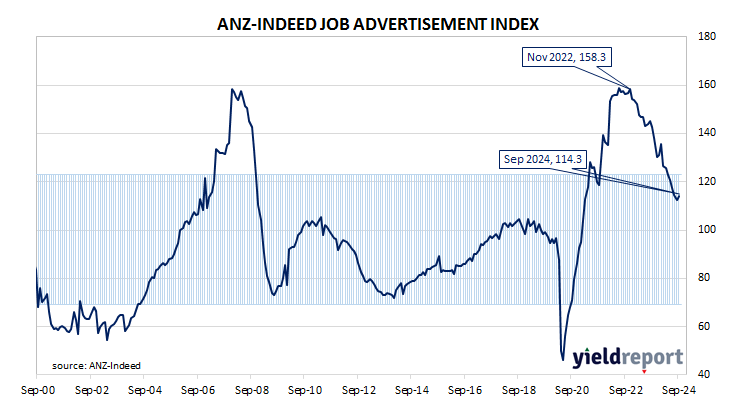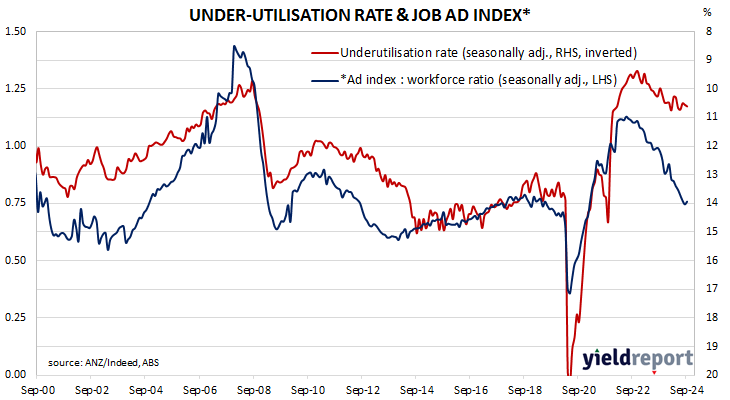Summary: Job ads up 1.6% in September; 19.8% lower than September 2023; ANZ: could signal declining trend is slowing; ACGB yields generally fall; rate-cut expectations firm; Indeed: gains relatively broad-based; ad index-to-workforce ratio increases.
From mid-2017 onwards, year-on-year growth rates in the total number of Australian job advertisements consistently exceeded 10%. That was until mid-2018 when the annual growth rate fell back markedly. 2019 was notable for its reduced employment advertising and this trend continued into the first quarter of 2020. Advertising then plunged in April and May of 2020 as pandemic restrictions took effect but recovered quite quickly, reaching historically-high levels in 2022.
According to the latest reading of the ANZ-Indeed Job Ads Index, total job advertisements in September increased by 1.6% on a seasonally adjusted basis. Their index rose from 112.5 in August after revisions to 114.3, with the gain following falls of 1.8% in August and 2.5% in July. On a 12-month basis, total job advertisements were 19.8% lower than in September 2023, up from August’s revised figure of -22.4%.
“While the series is down 15.8% since January, this could signal the trend of decline since 2022 is slowing,” said ANZ economist Madeline Dunk.
The figures came out on the same day as several other private sector surveys and Commonwealth Government bond yields generally fell, although ultra-long yields rose in what was probably a catch up from the previous day’s lack of movement. By the close of business, the 3-year ACGB yield had shed 7bps to 3.69%, the 10-year yield had lost 5bps to 4.17% while the 20-year yield finished 7bps higher at 4.56%.
Expectations regarding rate cuts in the next twelve months firmed, with a February 2025 rate cut priced in as an 80% probability. Cash futures contracts implied an average of 4.315% in November, 4.245% in December and 4.175% in February 2025. September 2025 contracts implied 3.675%, 66bps less than the current cash rate.
“Overall, Job Ads in September rose in three-quarters of occupations, compared to half in August, indicating that gains were relatively broad-based,” said Indeed Senior Economist Callam Pickering.
The inverse relationship between job advertisements and the unemployment rate or the underemployment rate has been quite strong (see below chart), although ANZ themselves called the relationship between the series into question in early 2019.
A higher job advertisement index as a proportion of the labour force is suggestive of lower unemployment rates in the near future while a lower ratio suggests higher unemployment rates will follow. September’s ad index-to-workforce ratio increased from 0.75 after revisions to 0.76.
In 2008/2009, advertisements plummeted and Australia’s unemployment rate jumped from 4% to nearly 6% over a period of 15 months. When a more dramatic fall in advertisements took place in April 2020, the unemployment rate responded much more quickly.



